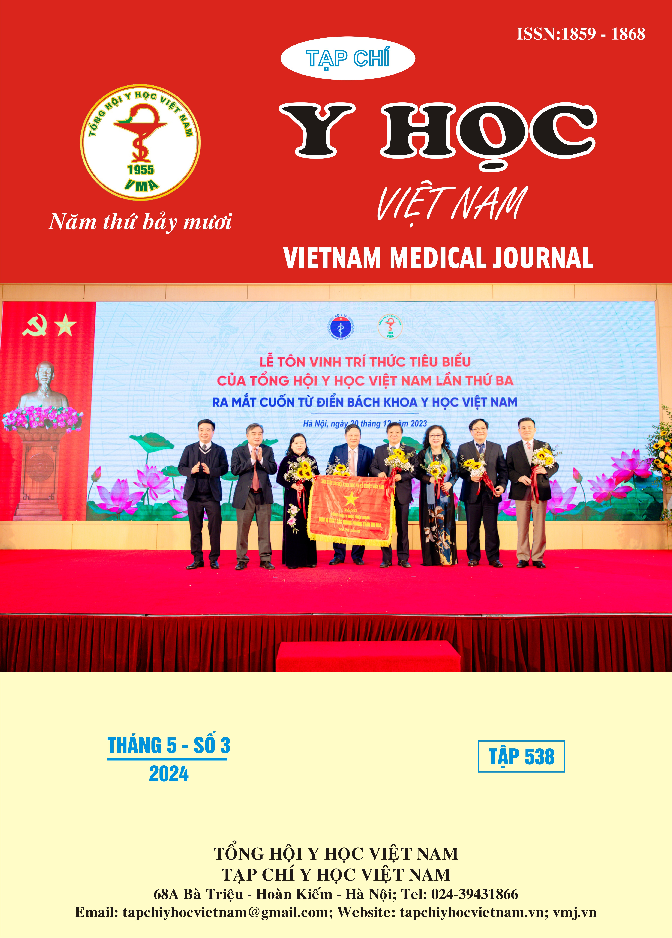NGHIÊN CỨU TỶ LỆ MẤT NGỦ VÀ MỘT SỐ YẾU TỐ LIÊN QUAN VỚI MẤT NGỦ Ở BỆNH NHÂN NHỒI MÁU NÃO
Nội dung chính của bài viết
Tóm tắt
Mục tiêu nghiên cứu: Nghiên cứu tỷ lệ mất ngủ và một số yếu tố liên quan với mất ngủ ở bệnh nhân nhồi máu não. Đối tượng và phương pháp nghiên cứu: Nghiên cứu tiến cứu, mô tả cắt ngang tại khoa Đột quỵ, Bệnh viện Quân y 103 từ 6/2023 – 1/2024. Kết quả: Tỷ lệ mất ngủ ở bệnh nhân nhồi máu não là 39,02%; Đái tháo đường, mức độ nặng đột quỵ theo NIHSS, mức độ tàn phế theo mRS và có hội chứng chân không yên (RLS-Restless legs syndrome) có liên quan với đến mất ngủ sau nhồi máu não. Trong đó, 2 yếu tố liên quan độc lập với mất ngủ ở bệnh nhân nhồi máu não là: đái tháo đường (OR: 7,014; 95%CI: 1,983-24,809; 0,003), có mRS ≥ 3 (OR: 12,128; 95%CI: 3,195-46,033; p < 0,001). Kết luận: Tỷ lệ mất ngủ ở bệnh nhân nhồi máu não là 39,02%; bệnh nhân có đái tháo đường, mức độ tàn phế theo mRS ≥ 3 là những yếu tố
Chi tiết bài viết
Từ khóa
Mất ngủ, nhồi máu não, đái tháo đường, tàn phế sau đột quỵ.
Tài liệu tham khảo
2. Gupta A., Shukla G., Mohammed A. et al (2017), "Restless legs syndrome, a predictor of subcortical stroke: a prospective study in 346 stroke patients", Sleep Med, 29, pp. 61-67.
3. Joa K.L., Kim W.H., Choi H.Y. et al (2017), "The Effect of Sleep Disturbances on the Functional Recovery of Rehabilitation Inpatients Following Mild and Moderate Stroke", Am J Phys Med Rehabil, 96(10), pp. 734-740.
4. Kim W.H., Jung H.Y., Choi H.Y. et al (2017), "The associations between insomnia and health-related quality of life in rehabilitation units at 1month after stroke", J Psychosom Res, 96, pp. 10-14.
5. David Gunawan Umbas A.S., Ashari Bahar, Muhammad Akbar, Andi Kurnia Bintang (2021), "Sleep quality in post stroke patient with and without type 2 diabetes mellitus: A comparative study", Sciencedirect, pp.
6. Xu H., Li W., Chen J. et al (2023), "Associations between insomnia and large vessel occlusion acute ischemic stroke: An observational study", Clinics (Sao Paulo), 78, pp. 100297.
7. Glozier N., Moullaali T.J., Sivertsen B. et al (2017), "The Course and Impact of Poststroke Insomnia in Stroke Survivors Aged 18 to 65 Years: Results from the Psychosocial Outcomes In StrokE (POISE) Study ", Cerebrovasc Dis Extra, 7(1), pp. 9-20.
8. Venkateshiah S.B., Ioachimescu O.C. (2015), "Restless legs syndrome", Crit Care Clin, 31(3), pp. 459-72.
9. Sechi G., Agnetti V., Galistu P. et al (2008), "Restless legs syndrome and periodic limb movements after ischemic stroke in the right lenticulostriate region", Parkinsonism Relat Disord, 14(2), pp. 157-60.
10. Yildiz D., Kahvecioglu S., Buyukkoyuncu N. et al (2016), "Restless-legs syndrome and insomnia in hemodialysis patients", Ren Fail, 38(2), pp. 194-7.


